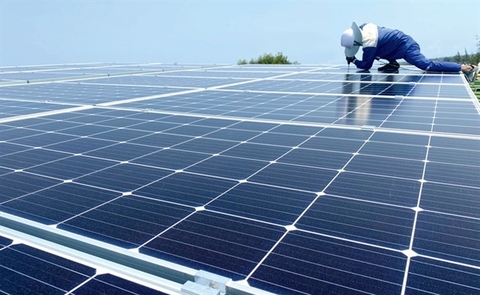
A solar power project in Ninh Thuan. Viet Nam’s electricity output is forecast to rise to 950 billion kWh by 2045. — Photo baodautu.vn
Viet Nam’s electricity output is forecast to rise to 950 billion kWh by 2045 to meet the growing demand for economic expansion.
Vice President of the Viet Nam Energy Association Nguyen Van Vy gave this estimate at a forum on solutions to develop renewable energy held in Ha Noi on Wednesday.
Development of clean and renewable energy is an irreversible trend around the world, changing the structure of the energy sector. Many countries around the world have urgently developed and implemented policies to promote renewable energy with a long-term vision, investing in human resources, technology and finance-credits towards building a low carbon economy.
Viet Nam has many favourable conditions to develop different renewable energy sources. The annual average number of sunshine hours in the North ranges from 1,500-1,700 hours and up to 2,700 hours in the South Central provinces. Solar radiation density varies between 3,000 and 5,000 kCal/m2/day.
The Earth Win Map estimates more than 39 per cent of Viet Nam’s land area has an average annual wind speed of over 63/s at an altitude of 65m and 8 per cent of the land area has an average wind speed of over 7m/s, which is suitable for large wind power stations.
According to Vy, as Viet Nam’s economy continued growing quickly, demand for primary energy sources is expected to increase by 4.6 per cent per year, from 105 MTOE (million tonnes of oil equivalent) in 2020 to 321 MTOE by 2045.
Over the past 10 years, electricity production has increased by more than 2.3 times, from 101.4 billion kWh in 2010 to nearly 235 billion kWh in 2019. Viet Nam’s electricity output is forecast to continue rising, at an average rate of 5.6 per cent per year from 245 billion kWh in 2020 to 950 billion kWh by 2045.
“Although the rate of fossil fuel use in electricity production is forecast to decrease, fossil fuel sources (coal and gas) still account for a large proportion. This will put great pressure on exhausted natural resources, and the increasing demand for fuel imports for electricity generation will greatly affect climate change and energy security,” Vy said.
“Therefore, the development of renewable energy should be paid higher attention for rapid development in the future.”
The Politburo’s Resolution No. 55-NQ/TW on Viet Nam's national energy development strategy to 2045, issued in February this year, has set a target for renewable energy to account for about 15-20 per cent of total electricity supply by 2030 and 25-30 per cent by 2045.
To achieve these goals, the Ministry of Industry and Trade has advised and submitted to the Prime Minister for promulgation mechanisms to encourage the development of wind power, biomass power, power generation from solid waste and solar power.
Such policies include support mechanisms for purchasing biomass, solar and wind power, incentives for corporate income tax, import tax, VAT tax and land-use tax.
Data from the Ministry of Industry and Trade (MoIT) showed by the end of September, the installed capacity of wind power reached 485MW, solar power 5,829MW, biomass power 169MQ.
Ending September, electricity generated from wind power reached 630 million kWh, solar power 7,274 million kWh, biomass power 303 million kWh, accounting for 4.4 per cent of total electricity output nationwide.
As for rooftop solar power, by mid-October more than 57,000 systems have been installed with a total capacity of 1,747MWp.
Do Duc Quan, deputy director of MoIT’s Department of Electricity and Renewable Energy, said the orientation in the future will focus on developing policies, transmission infrastructure and system operation regulations.
“In terms of policies, large-scale renewable energy projects will apply the bidding mechanism following which a selected developer will be the one offering the lowest electricity price from ground-mounted and floating solar power projects,” Quan said.
According to Quan, the bidding mechanism will take more time but be more fair and transparent for investors, ensuring harmony between the number of renewable energy power projects and capacity of transmission grids. — VNS